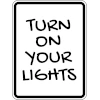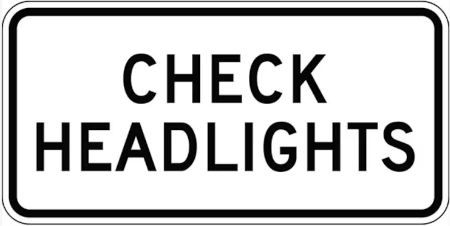 The next time you get into your vehicle, start it up, set the parking brake, turn on all of the lights and the hazard flashers. Walk around your vehicle and check all the lights. Are they all lit as they should be, and are the lenses clean, intact and still the right colour? If so, you are good to go from the standpoint of lights at least.
The next time you get into your vehicle, start it up, set the parking brake, turn on all of the lights and the hazard flashers. Walk around your vehicle and check all the lights. Are they all lit as they should be, and are the lenses clean, intact and still the right colour? If so, you are good to go from the standpoint of lights at least.

Which Lights Do I Check?
For most vehicles today you should find high and low beam headlights, signal lights, park lights and side marker lights at the front. At the rear it will be brake lights, tail lights, signal lights, license plate light, back up lights, and side marker lights. Some larger commercial vehicles will also have clearance and identification lights.
Auxiliary Lights
If you choose to install other approved auxiliary lights such as fog or driving lights, you will need to check them as well.
Don't Forget the Reflectors
Don't forget to check the reflectors. These must be yellow on both sides at the front and red at both sides at the rear as well as red at both sides of the rear. If you break down and can't turn the lights on, reflectors are your only protection during darkness.
Incidentally, this is another good reason not to park facing the wrong way on the street. You don't have protective reflectors on the front of your vehicle.
Headlight Aim
Are your headlights aimed properly? If they all function but point in the wrong direction they don't help you see and they hurt the other drivers ability to see. If misalignment is visible to you, it is well past time to have the aim corrected.
Fixing the Daytime Running Light Problem
Now that this critical equipment is there and functional, we have to remember to use it. Transport Canada took a significant step when it mandated daytime running lights (DRLs) 30 years ago, but it took until this year to remember the rear lights.
Effective in 2021 vehicle manufacturers will have to use one of three solutions:
- Have daytime running lights and tail lights come on when the vehicle instrument panel is illuminated and the vehicle is in operation
- Automatically turn on the headlights, tail lights, and side marker lights in low-light conditions
- Keep the driver’s instrument panel dark so the driver knows to turn on all the lights.
Remember K.B.L.
We will have to remember to turn on all the lights at night for some time to come. One good suggestion is to remember K.B.L. (Keys in Ignition, SeatBelt, Lights) when you sit in the driver's seat to start any trip.
Perhaps we should move to the other extreme and remove the driver's ability to turn off the lights.
Having One Light Out
Having one headlight, tail light or brake light out is but one step away from having no head, tail or brake lights. If you don't have functioning low beam headlights, tail lights or brake lights your vehicle is in an out of service condition.
Should you be stopped, the officer may choose to send you away by tow truck in addition to any other enforcement action such as a traffic ticket or a vehicle inspection order.
Learn More
Share This Article
I am finding more and more often that drivers are not checking their marker or brake lights. I encounter at least 2 vehicles a day with one or no functioning brake lights. Are the police actually ticketing or warning people because this seems to be an increasing problem, and I would imagine that this would or could be a cause of accidents especially at night. I also wonder in how many cases of a rear end collision that is caused by the above but not attributed to brake lights not functioning correctly.
- Log in to post comments
Our Canadian regulations need to be updated and for once what the Americans do should not be a consideration. Over the last few years I have seen a relaxation regarding DRL's to where the newer Kenworths one often sees the clearance lights before you spot the DRL's
Things I would like to see mandatory in Canada
- Automatic headlights
- If dash lights on all outside lights must be illuminated
- Headlight washers
- White only DRL's of a specific intensity and size
- Rear fog lights
- Taillight washers or at least a warning when lights obscured by snow and mud
- Adoption of European light standards. (They have some really neat lights)
- Outside mirrors that do not get covered with your own spray
- Outside mirror deicers
Canada has unique conditions we should not tie ourselves into a nation that does not have the same weather and lighting conditions.
- Log in to post comments
Now that this critical equipment is there and functional, we have to remember to use it. Transport Canada took a significant step when it mandated daytime running lights (DRLs) 30 years ago, but it took until this year to remember the rear lights. Effective in 2021 vehicle manufacturers will have to use one of three solutions:
- Have daytime running lights and tail lights come on when the vehicle instrument panel is illuminated and the vehicle is in operation
- Automatically turn on the headlights, tail lights, and side marker lights in low-light conditions
- Keep the driver’s instrument panel dark so the driver knows to turn on all the lights.
I don't know how manufacturers ever got away with having the dashboard illumination turn on just because the DRL's turned on.
It's ridiculous that this was ever considered acceptable.
When I'm driving, it's been a long time habit for me to turn the switch to parking lights, thus illuminating front and rear (plus sidemarkers) whilst having the benefit of the DRL's, which are designed to make you be seen more easily by other road users. Until dusk of course, then it's normal headlights.
5. Rear fog lights
Yeah, there's an interesting item. These things are manadatory in the EU countries, being an additional high intensity red light showing at the rear of the vehicle. But it's rare to ever see them over here.
Meanwhile, I rented a new Citroen in the UK a year ago, and I was horrified by how pathetic the low beams were on unlit country roads. I mentioned it to my brother, who then pointed out the adjustment switch on the dashboard, for intensity and angle. Woah, made all the difference in the world! I've never encountered that on any vehicles over here, and wonder if it's even available?
Heck, I'll throw in one more observation about european vehicles - they all have proper amber turn signal lights, at both the front and the rear, plus the sides of the front fenders!
This is not a cosmetic issue. They should be mandatory on cars sold here as well, as amber flashing lights are way more obvious for both vehicles following, and pedestrians/cyclists adjacent to the vehicle that's about to move sideways. Instead, manufacturers such as BMW and Mercedes actually change their lenses for north american use, from amber to red. Bloody ridiculous, and there's no excuse or reason for it.
On the other hand, of course, it probably doesn't matter when it comes to BMW's. They don't know how to use the turn signals anyway ...
- Log in to post comments
As a professional driver, 4 hours was the standard for pulling over and doing a walk around of the truck/trailer configuration I was responsible for on that trip. In heavy snow conditions, it wasn't unusual to find tail lights almost completely obscured with snow. Incandescant lights generated enough heat to keep a very small portion of the buildup melted, providing some small measure of protection in the way of being seen by drivers behind.
L E D lights generate no heat at all, which allows snow buildup to quickly, and completely, obliterate, visibility of tail lights. Depending on configuration of the trailer, placement of lights, and amount of diodes in the lense itself, a trailer could be completely invisible, (in light sense anyhow) in as little as 20 minutes. Maybe Grote, TruckLite, Pederson, and the others, need to incorporate a heating element into taillights, to address this issue. (Which kind of goes against one of the biggest selling points that LED lights have, low current draw)
Most of my equipment has provisions for 4, four inch stop/turn/brake lenses, on each side. In winter, I run a combination of LED and incandescent lenses on the rear, although I don't face the challenges most do, based on the fact that the majority of my travel is on the coast, or close to it.
- Log in to post comments
- Log in to post comments

Brake Lights